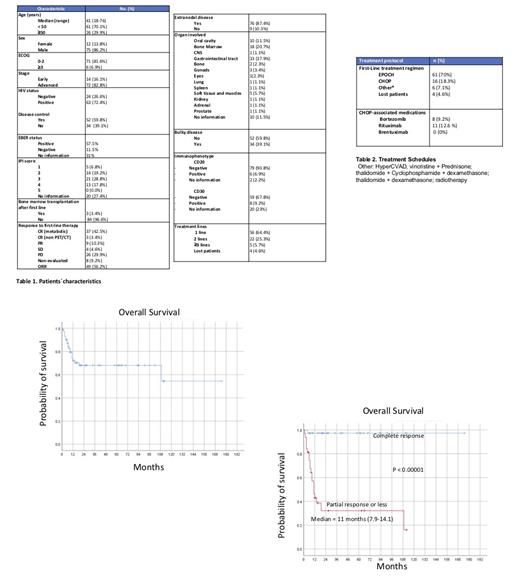Introduction
Plasmablastic lymphoma (LP) is a highly aggressive hematologic malignancy that has been recently described. Usually appears in immunocompromised patients, generally in the context of human immunodeficiency virus (HIV) coinfection, post-transplant status, or immunosenescence. To date, there is no standard care treatment in the first line, however, high-intensity regimens, generally EPOCH is the most described in the literature. We present the largest cohort of patients with Plasmablastic lymphoma published to date in the region, which includes patients diagnosed and treated in various medical centers in Latin America.
Methods
Data was collected from 11 medical centers throughout Latin America, including patients from Colombia, Argentina, Cuba, Ecuador, Mexico, and Paraguay. Data were recorded from a predetermined collection instrument, and unified in a single database.
Results
A total of 87 patients were diagnosed between 2008 and 2023. Twelve (n=12) were women (13.8%) and 75 men (86.2%), with an age between 18 and 76 years (median age 41 years). Most of the patients were under 50 years of age at debut (70.1%), and the majority were HIV positive (72.4%). Of the entire cohort, 82.8% presented advanced disease, only 16.1% presented early disease. Extra-nodal involvement was observed in 76 patients (87.4%), being the most frequent sites of involvement the gastrointestinal tract (33 patients - 37.9%), followed by the bone marrow and oral cavity. Among the patients who received at least one dose of therapy, the IPI was available in 72.6%, being IPI 1 6.8%, IPI 2 19.2%, IPI 3 28.8%, IPI 4: 17.8%, missing data 27.4%. Regarding the first-line treatment, most patients received EPOCH n=61 (70%). After first-line treatment, 45.9% achieved a complete response, 9 patients (10.3%) achieved a partial response, 4 patients (4.6%) stable disease, and 29.9% of patients (n= 26) had refractory disease. It is important to mention that 14 patients died without starting treatment (16%), the majority due to complications related to lymphoma. Among the patients who started therapy, with a median follow-up of 15 months, progression-free survival was 34 months (1-108), and overall survival was not reached. Median overall survival was not reached in patients who achieved complete response and was only 11 months (7.9-14.1) in patients with partial response or less (p<0.0001). In the multivariate analysis, the only independent predictor of survival was reaching a complete response with a HR of 0.007 (0.1-0.345).
Conclusion
To the best of our knowledge, our series is the largest in the region where we found that the most important determinant of survival is the fact of achieving a complete response after first line of treatment.
Disclosures
Martinez-Cordero:Sanofi: Research Funding. Peña:Janssen: Other: Congress Travel expenses. Castillo:Loxo: Consultancy, Research Funding; Mustang Bio: Consultancy; Kite: Consultancy; Cellectar: Consultancy, Research Funding; BeiGene: Consultancy, Research Funding; AstraZeneca: Consultancy, Research Funding; Abbvie: Consultancy, Research Funding; Pharmacyclics: Consultancy, Research Funding.


This feature is available to Subscribers Only
Sign In or Create an Account Close Modal